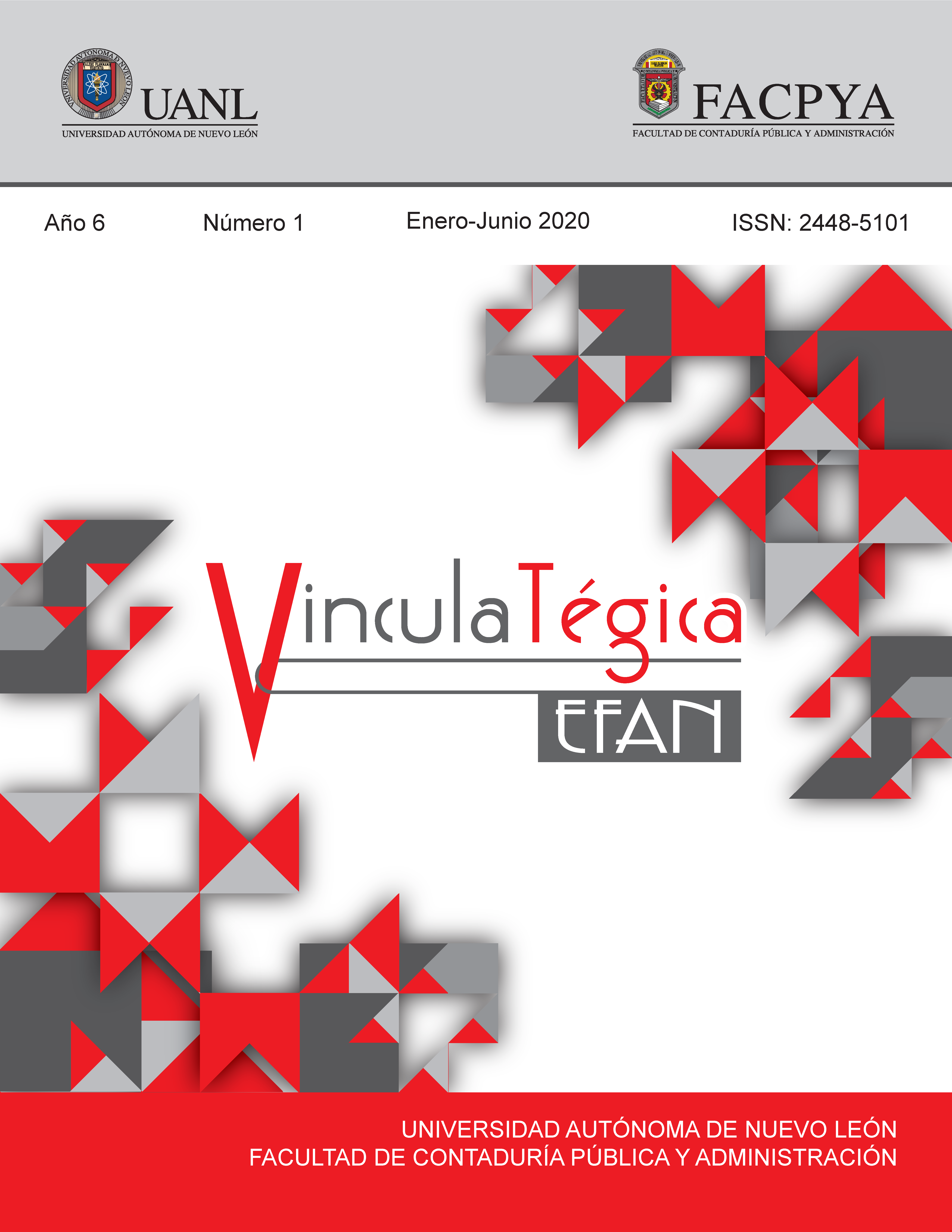BIG DATA ANALYTICS COMO RECURSO INTANGIBLE GENERADOR DE VALOR EN LA INDUSTRIA DEL RETAIL: CASO DE ESTUDIO OXXO
DOI:
https://doi.org/10.29105/vtga6.1-556Keywords:
Big Data Analytics, OXXO, Recursos intangibles, RetailAbstract
Big Data Analytics has helped the retail industry to
create business strategies based on the knowledge
generated by each purchase.
The overall objective of this research is to
understand the challenges that the retail industry
faces in trying to implement Big Data Analytics for
value generation. The company OXXO was
analyzed as a case study.
This research is based on the resource-based view
(Wernerfelt, 1984), the Theory of Company
Growth (Penrose, 1959) and the model of "The
158
formation and value of technology resources"
proposed by Wade and Nevo (2010).
It was found that OXXO has NOT achieved a
correct synergy between Big Data Analytics and its
organizational resources, because it has four
challenges in the implementation of Big Data
Analytics, these are: the lack of communication
between departments, lack of standardization in
processes , human factor and the scope that the
technological tool can have.
Downloads
References
ANTAD (2019). Compendio de Variables Económicas y de Indicadores ANTAD. ANTAD. Recuperado de: https://antad.net/indicadores/indicantad/ ….. (2019). El panorama del retail en 2019. ANTAD. Recuperado de: https://antad.net/el-panorama-del retail-en-2019/
Balaji, M. S., & Roy, S. K. (2017). Value co-creation with Internet of things technology in the retail industry. Journal of Marketing Management, 33(1/2), 7–31. https://ezproxy.udem.edu.mx:2152/10.1080/0267257X.2016.1217914 DOI: https://doi.org/10.1080/0267257X.2016.1217914
Barney, J. (1991). Firm Resources and Sustained Competitive Advantage. Journal of Management, 17(1), 99. DOI: https://doi.org/10.1177/014920639101700108
Barra, B. (2006, noviembre 29). Percepción de la efectividad de sistemas de TI en los procesos administrativos de las Pymes:Caso OXXO. Recuperado de https://repositorio.tec.mx/bitstream/handle/11285/567582/DocsTec_4831.pdf?sequence=1
Bowman, C., & Ambrosini, V. 2000. Value creation versus value capture: Towards a coherent definition of value in strategy. British Journal of Management, 11: 1–15 DOI: https://doi.org/10.1111/1467-8551.00147
Breidbach, C. F., & Maglio, P. P. (2016). Technology-enabled value co-creation: An empirical analysis of actors, resources, and practices. Industrial Marketing Management, 56, 73–85. doi:10.1016/j. indmarman.2016.03.011 DOI: https://doi.org/10.1016/j.indmarman.2016.03.011
Brown, B., Chui, M., Manyika, J. (2011), “Are you ready for the era of ‘Big Data’”, McKinsey Quarterly, Vol. 4 No. 1, pp. 24-35.
Daum, J. H. (2003). Intangible assets and value creation. John Wiley & Sons
Dyer, J & Singh, H, 1998. The relational view: cooperative strategy and sources of interorganizational competitive advantage. Academy of Management Review 23, 660 – 679 DOI: https://doi.org/10.5465/amr.1998.1255632
FEMSA (2019). División de proximidad. FEMSA. Recuperado de: https://www.femsa.com/es/unidades-de negocio/femsa-comercio/division-proximidad/
FEMSA Comercio (2018). FEMSA Comercio Informe Anual 2018. FEMSA Recuperado de: https://femsa.gcs-web.com/static-files/33756e1e-0f28-41eb-8162- 4d8a0b8120d533220C80C0AA3323DC14C2FE4D6EB60B579DE3D64B204B764E8D4
Grant, R.M. (1991). The Resource-Based Theory of Competitive Advantage: Implications for Strategy Formulation. California Management. Rev., Spring, pp. 114-135. DOI: https://doi.org/10.2307/41166664
Hernández-Leal, E. J., Duque-Méndez, N. D., & Moreno-Cadavid, J. (2006, 20 julio). Big Data: una exploración de investigaciones, tecnologías y casos de aplicación. Recuperado 15 marzo, 2017, de https://www.redalyc.org/pdf/646/64602005.pdf DOI: https://doi.org/10.22430/22565337.685
Euromonitor ( 2019). Convenience stores in Mexico. Recuperado de base de datos Euromonitor Password. ….. (2019).Retailing in Mexico. (2019). Recuperado de base de datos Euromonitor Passport.
Hernández, S., Méndez, S., Mendoza, C. & Cuevas A. (2016). Fundamentos de Investigación. McGraw Hill Education. Primera Edición.
IBM (S.A.). Análisis del Big Data, ¿Qué es big data? IBM. Recuperado de: https://www.ibm.com/mx es/analytics/hadoop/big-data-analytics
….. (S.A.). IBM Watson Studio. IBM. Recuperado de: https://www.ibm.com/mx-es/cloud/watson-studio
Indacochea, A. (2016). El análisis interno: recursos, capacidades y competencias centrales. En Estrategia para el éxito de los negocios (3rd ed., pp. 89-104). CENGAGE Learning.
Itami, H.(1987). Mobilizing Invisible Assets. Harvard University Press, Cambridge. DOI: https://doi.org/10.4159/9780674038981
González, A., Leiton, G., Rodríguez, V., and Salazar, A. (2019) “Recursos y capacidades empresariales de la industria del retail: La estrategia de internacionalización de OXXO en América Latina” (Tesis de pregrado) Universidad de Monterrey, N.L
Lepak, D. P., Smith, K. G., & Taylor, M. S. (2007). Value creation and value capture: A multilevel perspective. Academy of management review, 32(1), 180-194. DOI: https://doi.org/10.5465/amr.2007.23464011
Martínez Carazo, P. C. (2006, 20 julio). El Método de Estudio de caso estrategia metodológica de la investigación científica. Recuperado 30 enero, 2020, de https://www.redalyc.org/pdf/646/64602005.pdf 172
McAfee, A., Brynjolfsson, E., Davenport, T. H., Patil, D. J., & Barton, D. (2012). Big Data: the management revolution. Harvard business review, 90(10), 60-68.
Ohlhorst, F.J. (2012), Big Data Analytics: Turning Big Data into Big Money, John Wiley & Sons DOI: https://doi.org/10.1002/9781119205005
OXXO. (2019). Quienes somos?. Enero 31, 2020, de OXXO recuperado de: https://www.oxxo.com/quienes somos
Pan, Y. (2016). Heading toward artificial intelligence 2.0. Engineering, 2(4), 409-413. DOI: https://doi.org/10.1016/J.ENG.2016.04.018
Pantano, E. (2014). “Innovation drivers in retail industry.” International Journal of Information Management, Vol.34 No.3 Recuperado de https://www.sciencedirect.com/science/article/pii/S0268401214000309 DOI: https://doi.org/10.1016/j.ijinfomgt.2014.03.002
Pantano, E., Priporas, C. and Dennis, C. (2018), "A new approach to retailing for successful competition in the new smart scenario", International Journal of Retail & Distribution Management, Vol. 46 No. 3, pp. 264-282. https://doi.org/10.1108/IJRDM-04-2017-0080 Recuperado de https://www.emerald.com/insight/content/doi/10.1108/IJRDM-04-2017-0080/full/html DOI: https://doi.org/10.1108/IJRDM-04-2017-0080
Porter, M.E. (1990). Competitive Advantage of Nations. Harvard Business Review 74-91 DOI: https://doi.org/10.1007/978-1-349-11336-1
Power Data (S.A.) Data Warehouse. Power Data. Recuperado de: https://www.powerdata.es/data-warehouse
Provost, F., Fawcett, T. (2013), “Data science and its relationship to Big Data and data-driven decision making”, Big Data, Vol. 1 No. 1, pp. 51-59 DOI: https://doi.org/10.1089/big.2013.1508
Rita, I. (2015). Oxxo y 7-Eleven ponen a México en ranking global. Expansión. Recuperado de: https://expansion.mx/negocios/2015/03/17/tiendas-de-conveniencia-ponen-a-mexico-en-el-top mundial
SAAS (S.A.). Analítica del big data. Qué es y por qué es importante. SAAS. Recuperado de: https://www.sas.com/es_mx/insights/analytics/big-data-analytics.html
Sales , X. (Junio de 14 de 2016). La importancia de los activos intangibles en la empresa. Obtenido de EADA Business School Blog: http://blogs.eada.edu/2016/06/14/activos-intangibles-en-la-empresa/
Santoro, G., Fiano, F., Bertoldi, B. and Ciampi, F. (2019), "Big Data for business management in the retail industry", Management Decision, Vol. 57 No. 8, pp. 1980-1992. https://doi.org/10.1108/MD-07- 2018-0829 DOI: https://doi.org/10.1108/MD-07-2018-0829
Teece, D., Pisano, G., y Shuen, A. (1997). Dynamic capabilities and Strategic Management. Strategic Management Journal, 18(7), 509-533. Recuperado de http://www.business.illinois.edu/josephm/BA545_Fall%202019/Teece,%20Pisano%20and%20Shue n%20(1997).pdf DOI: https://doi.org/10.1002/(SICI)1097-0266(199708)18:7<509::AID-SMJ882>3.0.CO;2-Z
Wade, M R and Nevo, S 2010, “The formation and value of IT-enabled resources: antecedents and consequences of synergistic relationships”, MIS Quarterly, 34, pp. 163–183 DOI: https://doi.org/10.2307/20721419
Wernerfelt, B. (1984). A resource‐based view of the firm. Strategic Management Journal. (5), 171-180. Recuperado de http://web.mit.edu/bwerner/www/papers/AResource-BasedViewoftheFirm.pdf DOI: https://doi.org/10.1002/smj.4250050207
Yin, R. I. (1984). Case Study Research: Design and Methods, Applied social research Methods Series, Newbury Park CA, Sage
Downloads
Published
How to Cite
Issue
Section
License

This work is licensed under a Creative Commons Attribution 4.0 International License.
a). Authors keep copyright and give the journal the right of the first publication of the work under a Creative Commons attribution license. This license allows others to share the work as long as original authorship and initial publication in this journal is acknowledged.
b). Authors may make other independent and additional contractual agreements for the non-exclusive distribution of the version of the article published in this journal (e.g., include it in an institutional repository or publish it in a book) as long as they clearly indicate that the work was published for the first time in this journal.







